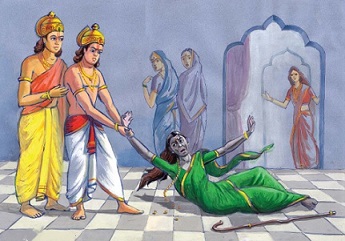
Without coming under the control of our lower self, we should raise ourselves to a higher emotional state
Our heart is capable of both noble and ignoble emotions. How we can cultivate higher emotions and curb lower emotions is demonstrated in the Ramayana through the interactions between the two pairs of inseparable brothers: Rama and Laksmana who are together in exile, and Bharata and Satrughna who are together in Ayodhya. Of course, these brothers are divine and are beyond lower emotions. Still, during their pastimes, for intensifying their loving reciprocations, they sometimes exhibit various emotions, some of which might seem like lower emotions. While remembering the transcendental position of such characters, we can also learn from their pastimes how we can channelize our emotions.
Anger Triggered by Suspicion
When Rama and Laksmana are living in the forest of Citrakuta, they hear the sounds of an approaching army. At Rama’s behest, Laksmana climbs atop a tree to identify the visitors and recognizes Bharata at their forefront. Laksmana, while serving Rama in the forest, is still angry to see that his brother, who should have been enjoying royal opulence, is instead enduring Spartan austerity in the forest. So when he sees Bharata coming with a huge army, he feels that his suspicion is confirmed: Bharata is in cahoots with his mother and has brought the army to eliminate Rama so that he can get the kingdom for not just fourteen years but for life. Enraged, he declares that he will singlehandedly kill Bharata and the whole army – everyone who dares threaten Rama.
But Rama remains calm and speaks of Bharata’s affection for him, which equals that of Laksmana. Rama correctly surmises that Bharata, being mortified at his mother’s intrigues, has come to return the kingdom.
Underscoring the unwarrantedness of Laksmana’s anger, Rama asks him whether the forest austerities have made him irritable towards others such as Bharata who were enjoying the royal luxuries that he was missing. If that were the case, Rama assures that he will ask Bharata to exchange places with Laksmana – Bharata will stay in the forest, while Laksmana can enjoy Ayodhya’s royal comforts.
Thoroughly embarrassed on being so strongly reproached, Laksmana falls silent. And his mortification at his misjudgment increases manifold when he sees how fervently Bharata beseeches Rama to take the kingdom and finally carries Rama’s sandals on his head.
Later, after the departure of the visitors from Ayodhya, Laksmana introspectively asks Rama: “Why am I so short-tempered?” Rama attributes Laksmana’s temper to his emotionality. Perplexed, Laksmana asks whether emotions are undesirable. Rama answers in the negative, but cautions that we need to choose the emotions that bring out our higher side, not our lower side.

Seeing Manthara dressed in fine jewelry, Satrughna feels his blood boil. He grabs her and shakes her violently in fury, while Manthara shrieks in moral fear
Anger Triggered by Cruelty
How to choose emotions thus is illustrated in an interaction between the other two brothers, Bharata and Satrughna. This incident occurs before they go to the forest to meet Rama. The two brothers are returning to their palace after having performed the funeral rites for their deceased father. Bharata, being the de facto head of state, is accosted by a city official about some administrative work. Satrughna moves on towards the palace and catches sight of Manthara. This scheming maid of Kaikeyi is the root of the conspiracy that led to the exile of Rama and the death of their father. Seeing her dressed in finery – evidently the rewards for successfully masterminding the conspiracy – Satrughna feels his blood boil, and he rushes forward to catch her. On seeing Satrughna and his expression, Manthara turns pale and flees towards Kaikeyi’s palace. But the doorkeeper, who like most residents of Ayodhya is incensed at the conspiracy, grabs Manthara and hands her to Satrughna, who shakes her violently in fury. The wicked maid shrieks in mortal fear, calling for her mistress. Kaikeyi rushes out and asks Satrughna to release Manthara. But the infuriated prince pays her no attention – the anger that has been burning within him for days now rushes forth unchecked.
Fearful of her stepson’s uncontrollable wrath, Kaikeyi looks around for help and sees her son, Bharata, approaching. She rushes to him, asking him to tell Satrughna to stop. Turning coldly away from her, Bharata asks his brother to desist, saying that he too has felt the impulse to do what Satrughna was doing – and do it not just with the maid, but also his mother. While Kaikeyi hears aghast, Bharata says that he has restrained that impulse by remembering that giving in to it will displease the very person whose cause they wanted to protect: Rama. Struck by this thought, Satrughna releases Manthara, who flees to Kaikeyi’s arms. And the two brothers walk on towards their palaces, discussing how they can best persuade Rama to return.
Thus, for Bharata and Satrughna, who they were angry against was not as important as who they were angry for. They countered the lower emotion of anger by holding on to the higher emotion of love for Rama. For all of us too, cultivating such higher emotions is vital for freeing ourselves from our lower emotions.
Indeed, human culture is meant to provide an environment wherein higher emotions can be nourished and lower emotions countered. Unfortunately, contemporary culture is increasingly doing the opposite, as can be seen, for example, in the ad industry.
Freudian Triggering of Lower Emotions
Advertisements are so ubiquitous today that we may not realize for millennia human society lived without them. No doubt, people have always promoted their products, but such promotion was never a whole industry – and certainly not a multi-billion dollar industry. The advertising behemoth took birth soon after the industrial revolution gained steam in the eighteenth and nineteenth centuries. Once goods started becoming mass-produced, promoting them became a big part of the economy and the culture at large. Ads can conceivably help us by informing us about useful products. But that’s not the intent behind most ads nowadays. Till the end of the nineteenth century, ads usually focused on the qualities of the products, thereby appealing to customers’ intelligence. But then came Sigmund Freud with his ideas about human psyche.
One of Freud’s insights was that our rational intelligence is like a small raft atop a vast turbulent ocean whose waves are our irrational emotions. People can be exhorted to do the right thing by appealing to their rationality. But if something triggers their irrational emotions, it can easily overpower their intelligence, as waves can overturn a raft. Being driven by such emotions, people end up doing terrible things, against their own better intelligence.
The bhakti tradition will see here rough parallels with the concept of the three modes of material nature: goodness, passion and ignorance. These modes comprise a framework for analyzing the nature of things, especially in terms of their psychological effects on us. What Freud calls the rational faculty correlates with the higher mode of goodness. This mode, the Bhagavad-gita (18.30) states, illumines us with the intelligence to discern what should be done and what shouldn’t be. What Freud calls the irrational emotions correlates with the lower modes of passion and ignorance. These modes impel us to act on the spur of the moment, neglecting others’ and our own intelligence’s warnings that such actions are counterproductive.
Actually, the irrational emotions don’t exactly destroy the rational intelligence; they subordinate and misappropriate it for their own purposes. Consequently, those under the grip of such emotions often exhibit intelligence, but that intelligence instead of restraining irrational emotions is misdirected by them. Recent history demonstrated this in Nazi Germany’s misusing cutting edge scientific advances in fields such as eugenics to irrationally victimize Jews and others in the Holocaust.
This theme of lower emotions hijacking our rational intelligence is seen in the Bhagavad-gita’s description of intelligence in the modes of passion and ignorance. We might be inclined to assume that intelligence would correlate with the mode of goodness. Our assumption would be correct, but not complete. The lower modes too feature intelligence, but intelligence abused for unintelligent purposes, being driven by irrational emotions.
Significantly, Gita wisdom also describes a stable state of existence beyond both the ocean and the raft: the state of transcendence. Beyond the three material modes is our pure existence as spiritual beings. We as souls have pure emotions centered on selfless love for God and all living beings in relationship with him. But as the light coming from a white bulb becomes colored if that bulb is placed in a colored case, so too the original pure emotions of the soul become distorted due to the coverings of the modes.
When Rama tells Laksmana to cultivate elevating emotions and avoid degrading emotions, he is essentially telling us to cultivate goodness and transcendence, and avoid passion and ignorance. But the ad industry, using Freud’s ideas, does the opposite – or, more precisely, makes us do the opposite.
Advertisers recognized that people could be more forcefully persuaded to purchase products by appealing to their emotions than to their intelligence. So they started using all their intelligence to design ads that capitalized on people’s irrational emotions.
Torches of Freedom Light the Path to Self-injury
Few things illustrate the deluding power of such advertising as graphically as the “Torches of freedom” campaign to make women smoke. This campaign’s high point – or rather low point – was the Easter Sunday Parade of 1929 in America. During that parade, many of the leading female icons were paid to smoke a cigarette custom-made for women – a cigarette that was called the “torch of freedom.” As the women’s liberation movement was then increasingly capturing the female imagination, the idea of brandishing a “torch of freedom” resonated so strongly with their emotions that the rational question how smoking signified freedom was just swept away. Millions of women started smoking, not just in America, but also in much of the Western world. Only decades later were brought to light the harms of smoking, especially for women, all the more for pregnant women. Thus, the “torches of freedom” ended up lighting for millions the road to self-injury.
While most ad campaigns may not be that insidious, still they operate on the same principle of exploiting our emotions. They use human intelligence to trigger human irrationality. Advertisers use their best intelligence based on meticulous research into human psychology to make customers crave and slave for their products. Most ads focus not on how good the product is, but on how good the product will make us feel. Thus, advertising becomes pop psychology, which comes streaming into our living rooms through our television sets. By their clever (cunning?) design, ads catch our emotions and thereby our wallets.
And ads are just one of the many things in today’s society that exploit us by triggering our lower emotions. To protect ourselves from such emotional manipulation, we need to understand how we can activate and strengthen our higher emotions.
Devotion Brings out Our Best
Relationships often help us bring out our higher side. Our desire to please the person whom we love inspires us to act properly, thus expressing our higher emotions. And our desire to not displease our loved one empowers us to avoid acting improperly, thus restraining our lower emotions. Of course, this happens only when that person is of basically good character. Otherwise, when we are in bad association, the desire to please others brings out our lower side, as happened in the Mahabharata with Karna because of his desire to please the evil Duryodhana.
Caitanya Carana Dasa is the associate-editor of Back to Godhead (US and Indian editions). To read his daily Bhagavad-gita reflections, please subscribe to Gitadaily on his website, thespiritualscientist.com.
